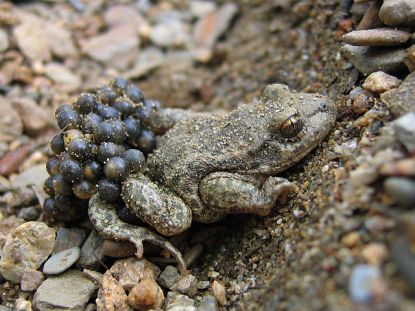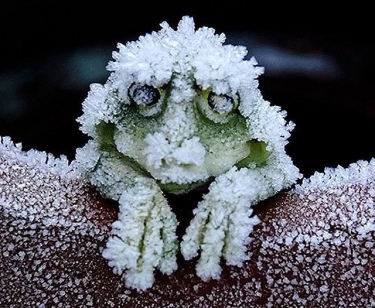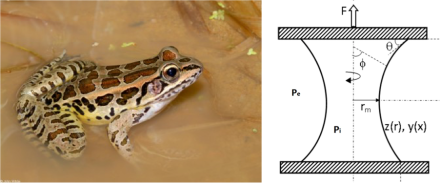In case you hadn’t noticed, today is February 29! That means this is a leap year. Occurring once every four years, leap years have 366 days rather than the usual 365, with the additional day occurring on February 29th. The name “leap year” originates from the fact that while a fixed date in the calendar normally advances one day of the week for each advancing year, the same day of the week of a leap year will advance two days from March onward, due to the addition of the extra day. Other than keeping the calendar year synchronized with the astronomical or seasonal year and all the corresponding traditions, folklore, and superstitions, the leap year event is a little lackluster. Leap Day doesn’t have any special foods or colors or a day off work.
But have you ever searched Google images for “leap year day”? Go ahead, try it. I will wait… (Please note, it is important to include the word “day” or you will only get images of the 2010 movie Leap Year).

So what did you find? Were you flooded with images of green-cute cartoon frogs in the act of leaping, which may or may not be associated with a calendar or the number 29? I started to wonder why it is that leap year has been associated with green-cute cartoon frogs. Perhaps it is because leap means “to jump or spring a long way, to a great height, or with great force.”1 But why frogs? Bunnies, kangaroos, grasshoppers, and sturgeon also leap. So do some spiders!
So who designated frogs the unofficial official mascot of the leap year? I couldn’t find an answer to that question, but regardless of which animal or insect would be your choice for the leap year mascot, I still go with the frog. Why? Well, Mother Nature and evolution have granted frogs some fantastical traits and abilities, which have inspired creative solutions and advances in nanotechnology, and nanoscale science gets my vote every day.
Sticky, Slimy, and Splendid
If I were to ask you to name an organism we could enlist for help in battling multi-drug resistant superbugs, frogs probably are not the first ones that come to mind. But consider for a moment their habitat; frogs are amphibians that live in bacteria- and fungi-ladened environments. Dr. J Michael Conlon, a biochemist at United Arab Emirates University, first recognized the potential of frog-inspired antimicrobial compounds as early as 1990.2 When a frog responds to stress, certain glands in the frog’s skin secret antimicrobial peptides.

These antimicrobial peptides have been shown to possess a broad spectrum of antibacterial and antifungal activity. Dr. Conlon and his research associates have made significant progress in antimicrobial and antifungal activity using the peptides exuded from the skin of the North American mink frog,3 the western clawed frog,4 and the midwife toad.5 These have shown great promise in killing MRSA and MDRAB, and other types of bacteria and fungi. (You may have heard of MRSA as a “superbug” that sometimes crops up in hospitals.6)
In addition to Dr. Conlon’s work, the antimicrobial peptides found in the African clawed frog have been attached to small electronic chips that emit an electrical signal when exposed to harmful bacteria, including pathogenic E. coli and Salmonella. Dr. Michael McAlpine at Princeton University believes these chips could replace current tests that are used to detect bacterial contamination of medical devices and drugs.7
Antifreeze On Demand
How many of us have experienced a winter flight delay? I am willing to bet a good majority of us have dealt with the annoying wait as runways are cleared or smelly de-icer is applied to our plane’s wings. But what if I told you these winter flight delays could become a distant memory and that we have a poisonous little frog to thank?

In a nutshell, aviation icing conditions exist when the air contains droplets of supercooled liquid water which can build up on the leading edge of the plane’s wings and other surfaces. Federal Aviation Regulations contain specific definitions of icing conditions that particular aircraft are certified to fly into.9 If the conditions are not just right, planes aren’t allowed to fly.
So how in the world does a poisonous dart frog solve aviation icing issues? Dr. Konrad Rykaczewski from Arizona State University was inspired by the way the poison dart frog secretes toxin through its skin.10 There is an outer layer of skin exposed to the environment, and an inner layer that releases poison when the frog is in danger. Now imagine the functionality of “poison-release on-demand” applied to antifreeze liquid for airplanes. Two nano-thin layers of “skin” would be applied to the airplane’s wings. The outer layer of airplane’s skin would be exposed to the environment, while the inner layer would be infused with the antifreeze liquid mixture. When the outer layer of the airplanes skin was in danger (i.e., aviation icing conditions) and began to freeze, the ice crystals would expand downward through the outer layer’s pores, eventually coming into contact with the antifreeze fluid and melting!
Capillary Bridges Make Graphene Dreams
Have you ever asked yourself “how does a frog keep their feet attached to a submerged leaf?” The picture below shows an example. Tree frogs use trapped air bubbles on their feet in order to stay afloat on the submerged leaves. These air bubbles form what are called capillary bridges. These bridges are stretched structures that exert an inward force on both ends, thus holding the frog to the leaf. Pretty simple huh?

Well, Dr. Loh Kian Ping and research associates from the National University of Singapore were inspired by this simple mechanism of attachment and used it to develop an innovative one-step method to grow and transfer high-quality graphene grown on silicon wafers. This process is called a “face-to-face” transfer.12 The graphene is grown on a copper catalyst on top of a silicon substrate. The copper is etched away while the graphene is held in place by capillary bridges attached to the silicon surface. This new method allows the thin, super-strong material to be simultaneously grown on copper and transferred onto a silicon wafer for use in technology like transistors and biosensors.
Not only has the frog motivated unique nano-scale research on antimicrobial peptides, automated airplane de-icing mechanisms, and graphene production; our amphibious companion has also been the source of inspiration for revolutionized scotch-tape,13 algorithm design for efficient wireless networks,14 and “molecular condoms” to protect against the spread of HIV.15 So who knows, maybe the new “transformer frog” discovered in Ecuador that has the ability to change its skin from spiny to smooth in under five minutes16 will provide the missing link for other vertebrate species to perform extraordinary and surprising feats of the imagination!
So when you are celebrating leap year today, say a silent thank you to the unofficial leap year mascot, the frog. I mean really, what awesome science has the sturgeon ever inspired?

EDUCATIONAL RESOURCES
- PBS NewsHour Extra: Lesson plan: How mimicking nature inspires new inventions(grades 9-12)
REFERENCES
- “Leap” Def 1. Oxford Dictionaries [online] Retrieved from http://www.oxforddictionaries.com/us/definition/american_english/leap
- Rovner, S. Frogs Inspire New Antimicrobials. Chemical & Engineering News. 2010 88 (37) 36-37. Retrieved from https://pubs.acs.org/cen/science/88/8837sci3.html
- Conlon, J., Ahmed, E., & Condamine, E.Antimicrobial properties of brevinin-2-related peptide and its analogs: Efficacy against multidrug-resistant Acinetobacter baumannii. Chemical Biology & Drug Design. 2009, 74(5):488-493. doi: 10.1111/j.1747-0285.2009.00882.x.
- Subasinghage, A., Conlon, J., & Hewage, C. Development of potent anti-infective agents from Silurana tropicalis: conformational analysis of the amphipathic, alpha-helical antimicrobial peptide XT-7 and its non-haemolytic analogue [G4K]XT-7. 2010, 1804(4):1020-1028. doi: 10.1016/j.bbapap.2010.01.015.
- Conlon, M. et al. The alyteserins: Two families of antimicrobial peptides from the skin secretions of the midwife toad Alytes obstetricans (Alytidae). Peptides. 2009. 30(6):1069-73. doi: 10.1016/j.peptides.2009.03.004
- Mayo Clinic Staff. MRSA Infection [website]. Retrieved from http://www.mayoclinic.org/diseases-conditions/mrsa/basics/definition/con-20024479
- Emery, C. New sensor derived from frogs may help fight bacteria and save wildlife. News at Princeton, Oct 19, 2010. Retrieved from https://www.princeton.edu/main/news/archive/S28/75/17O86/
- Snopes.com. Frogsicles. April 25, 2015. Retrieved from http://www.snopes.com/photos/animals/frozenfrog.asp
- Federal Aviation Administration. Rule Sets New Icing Standards for New Transport Airplanes [press release]. Retrieved from https://www.faa.gov/news/press_releases/news_story.cfm?newsId=17674
- Sun, X. et al. Bioinspired Stimuli-Responsive and Antifreeze-Secreting Anti-Icing Coatings. Advanced Materials Interfaces. 2015, 2, 1400479. doi: 10.1002/admi.201400479
- Virginia Department of Game & Inland Fisheries. Frog Fridays: Pickerel Frog. Retrieved from http://blog.wildlife.virginia.gov/2015/07/frog-friday-pickerel-frog/
- Gao, L. Face-to-face transfer of wafer-scale graphene films. Nature. 2013, 505 (190-194) doi: 10.1038/nature12763
- Halamkar, S. Frogs feet and nano hopes. LiveMint. Dec 15, 2011. Retrieved from http://www.livemint.com/Opinion/ve69cPPa6pOUo5trjd4w0N/Frogs-feet-and-nano-hopes.html
- Hernández, H. & Blum, C. Distributed graph coloring: an approach based on the calling behavior of Japanese tree frogs. Swarm Intelligence, 2012, 6(2), 117-150. doi: 10.1007/s11721-012-0067-2
- Ugaonkar, S. et al. An Intravaginal Ring for the Simultaneous Delivery of an HIV-1 Maturation Inhibitor and Reverse-Transcriptase Inhibitor for Prophylaxis of HIV Transmission. Journal of Pharmaceutical Sciences, 2015, 104(10):3426-3439. doi: 10.1002/jps.24551
- Guayasamin, J. et al. Phenotypic plasticity raises questions for taxonomically important traits: a remarkable new Andean rainfrog (Pristimantis) with the ability to change skin texture. Zoological Journal of the Linnean Society, 173 (4), 913-928. doi: 10.1111/zoj.12222

[…] original en inglés por Caley Allen Traducido por Jeremy […]